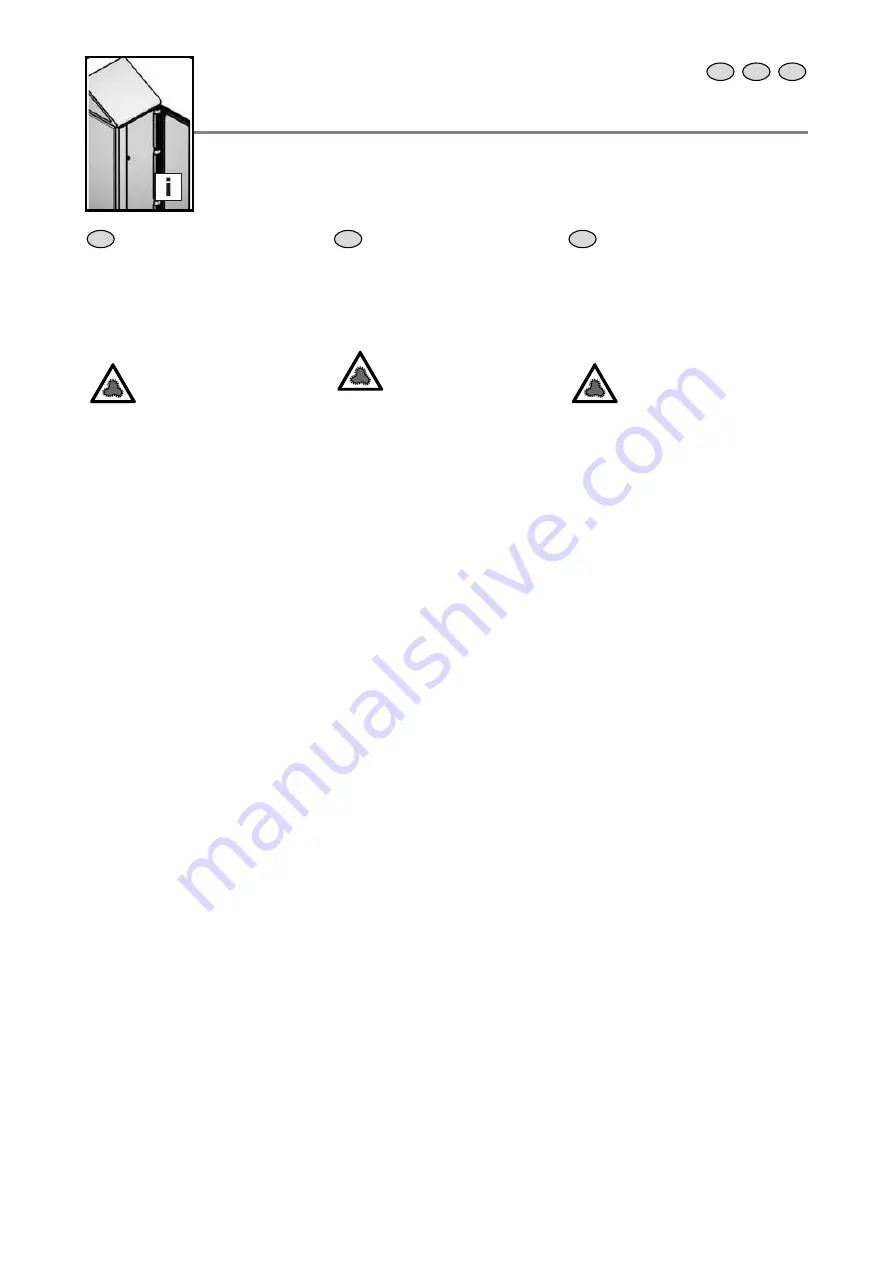
Systemschrank HD Montageanleitung / HD system enclosure assembly instructions / Szafa systemowa HD
– instrukcja montażu
8
Sicherheitshinweise / Safety notes /
Wskazówki dotyczące
bezpieczeństwa
Lebensmittelsicherheit
Die Hauptverantwortung für die
Lebensmittelsicherheit liegt nach der
Verordnung über Lebensmittelhygiene EG
852/2004 Artikel 1 Absatz 1 a beim
Lebensmittelunternehmer.
Hygiene
HYGIENERISIKO!
Die Entwicklung des
Systemschrankes HD wurde
unter Berücksichtigung der im
Abschnitt „Mitgeltende Dokumente“
genannten Normen und Richtlinien
durchgeführt.
Über eine Risikoanalyse wurden konstruktive
Hygiene-Schwachpunkte vermieden. Da sich
einige wenige Restrisiken nicht ausschließen
lassen, sind folgende Hinweise zu beachten.
Planung, Montage und Aufstellung
Sorgen Sie
für ausreichend große Boden-
und Wandabstände, damit eine einfache
und kontrollierbare Reinigung erfolgen
kann.
Die Installation des Systemschrankes HD
direkt über einem offenen Prozess zur
Lebensmittel-Herstellung ist zu
vermeiden. Ist dies aus Platzgründen
nicht möglich, muss dieser zur Bedienung
herausschwenkbar montiert werden.
Bringen Sie keine unnötigen
Gehäuseöffnungen ein.
Sind dennoch nach der Installation
Öffnungen vorhanden, müssen diese vor
Inbetriebnahme hygiene- und
schutzartgerecht verschlossen werden.
Verwenden Sie zur Installation an den
Gehäuse-Außenseiten nur
hygienegerecht gestaltete Bauteile.
Die Gehäuseoberflächen haben Rautiefen
< 0,8 μm. Ein Beschädigen der
Oberflächen begünstigt eine Ablagerung
von Mikroorganismen.
Verwenden Sie zur Klimatisierung des
Systemschrankes HD
flüssigkeitsdurchströmte Komponenten,
wie z. B. Luft/Wasser-
Wärmetauscher
oder Direct Cooling Package (DCP) in
Verbindung mit Prozesswasser oder
Rückkühlanlagen. Hiermit vermeiden Sie
wirkungsvoll die Ausbreitung schädlicher
Mikroorganismen, wie es z. B. beim
Lüfterbetrieb der Fall ist.
Betrieb und Instandhaltung
Der Innenraum des Systemschrankes HD
zählt nicht als Hygienebereich.
Öffnen Sie den Systemschrank HD daher
niemals, während Lebensmittel offen
verarbeitet werden.
Schließen Sie grundsätzlich alle
Vorreiber. Nur so ist eine zuverlässige
und hygienegerechte Abdichtung des
Innenraums gewährleistet.
Beschädigen Sie nicht die
Gehäuseoberflächen.
Kontrollieren Sie den Systemschrank HD
in regelmäßigen Abständen auf Schäden,
wie z. B. verkratzte Oberflächen und
beschädigte Dichtungen.
Wechseln Sie beschädigte Gehäuseteile
schnellstmöglich aus.
Food safety
In accordance with the regulation for food
hygiene, EU 852/2004 Article 1 Paragraph
1, the primary responsibility for food safety
lies with the food processing company.
Hygiene
HYGIENE RISK!
The development of the HD
system enclosure was
performed in accordance with
the standards and regulations mentioned
in the “Associated documents” section.
A risk analysis was performed to avoid
design-related hygiene weak points.
Because a few residual risks cannot be
avoided, the following notes must be
observed.
Planning, installation and erection
To ensure simple and controlled
cleaning, provide adequate floor and
wall clearances.
The HD system enclosure should not
be installed directly above an open
process for food processing. If this is
not possible for space reasons, to allow
operation, it must be installed so it can
be swung out.
Do not provide any unnecessary
housing openings. If, however,
openings are present after the
installation, they must be closed to
conform to the hygiene and protection
category requirements prior to
commissioning.
Use only hygiene-conform components
for the installation to the external
housing sides.
The housing surfaces have peak-to-
valley height < 0.8 μm. Damage to the
surfaces favour the formation of micro-
organism deposits.
Use liquid-fed components, such as
air/water heat exchanger or Direct
Cooling Package (DCP) in conjunction
with process water or recooling units,
for the climatic control of the HD
system enclosure. This effectively
prevents the propagation of dangerous
micro-organisms, for example, that
occur during fan operation.
Operating and maintenance
The interior area of the HD system
enclosure is not considered to be a
hygiene area.
Never open the HD system enclosure
while open foodstuff is being
processed.
Always close all fasteners. This is
essential to ensure a reliable and
hygienic sealing of the interior space.
Never cause any damage to the
housing surfaces.
Regularly inspect the HD system
enclosure for damage, such as
scratched surfaces and damaged
seals.
Replace any damaged housing parts
as quickly as possible.
Bezpieczeństwo żywności
Główna odpowiedzialność za bezpieczeństwo
żywności zgodnie z rozporządzeniem w
zakresie higieny środków spożywczych nr
852/2004 art. 1 ust. 1a spoczywa na
przedsiębiorcy spożywczym.
Higiena
RYZYKO DLA HIGIENY!
W projektowaniu szafy
systemowej HD uwzględniono
normy i wytyczne podane w
rozdziale
„Dokumenty współobowiązujące“.
Dzięki analizie ryzyka uniknięto słabych pod
względem higienicznym punktów
konstrukcyjnych. Ponieważ nie można
wykluczyć niektórych pozostałych zagrożeń,
należy przestrzegać poniższych wskazówek.
Projektowanie, montaż i ustawienie
Zapewnić wystarczająco duże odległości
od ścian i podłogi, tak aby ułatwić
czyszczenie i kontrolę.
Unikać instalowania szafy systemowej HD
bezpośrednio nad otwartym procesem w
produkcji żywności. Jeżeli ze względu na
miejsce jest to niemożliwe, to musi zostać
zainstalowana wychylnie.
W obudowie nie należy wykonywać
niepotrzebnych otworów.
Jeżeli jednak po zainstalowaniu pozostały
jakieś otwory, to przed uruchomieniem
muszą one zostać zamknięte w sposób
zgodny z wymaganiami higieny i stopnia
ochrony.
Do instalacji na zewnątrz obudowy
używać wyłącznie elementów
zaprojektowanych zgodnie z
wymaganiami higieny.
Powierzchnie obudowy mają
chropowatość < 0,8 μm. Uszkodzenia
powierzchni sprzyjają osadzaniu się
mikroorganizmów.
Do klimatyzowania szafy systemowej HD
używać komponentów wykorzystujących
przepływ cieczy, jak np. wymienniki ciepła
powietrze/woda lub Direct Cooling
Package (DCP) w połączeniu z wodą
przemysłową lub agregatami chłodzenia
cieczy. W ten sposób skutecznie unikną
Państwo rozprzestrzeniania się
szkodliwych mikroorganizmów, jak to ma
miejsce np. w przypadku korzystania z
wentylatorów.
Użytkowanie i konserwacja
Wnętrze szafy systemowej HD nie zalicza
się do obszaru higieny.
Dlatego nigdy nie należy otwierać szafy
systemowej HD podczas otwa
rtej obróbki
żywności.
Wszystkie zamki z zasady muszą być
zamknięte. Tylko w ten sposób można
zagwarantować niezawodne i zgodne z
wymaganiami higieny uszczelnienie
wnętrza.
Powierzchnie obudowy nie mogą być
uszkodzone.
Należy regularnie kontrolować szafę
s
ystemową HD pod kątem takich
uszkodzeń, jak np. zadrapania
powierzchni lub uszkodzone uszczelki.
Uszkodzone elementy obudowy należy jak
najszybciej wymienić.
PL
EN
DE
DE
EN
PL









































